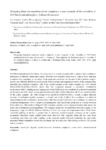Mostrar o rexistro simple do ítem
Designing binuclear transition metal complexes: a new example of the versatility of N,N′-bis(2-aminobenzyl)-4,13-diaza-18-crown-6
| dc.contributor.author | Vaiana, Lea | |
| dc.contributor.author | Platas-Iglesias, Carlos | |
| dc.contributor.author | Esteban-Gómez, David | |
| dc.contributor.author | Avecilla, Fernando | |
| dc.contributor.author | Clemente-Juan, Juan Modesto | |
| dc.contributor.author | Real, José Antonio | |
| dc.contributor.author | Blas, Andrés de | |
| dc.contributor.author | Rodríguez-Blas, Teresa | |
| dc.date.accessioned | 2017-10-27T10:20:35Z | |
| dc.date.available | 2017-10-27T10:20:35Z | |
| dc.date.issued | 2005-04-27 | |
| dc.identifier.citation | Designing binuclear transition metal complexes: a new example of the versatility of N,N′-bis(2- aminobenzyl)-4,13-diaza-18-crown-6. L. Vaiana, C. Platas-Iglesias, D. Esteban-Gómez, F. Avecilla, J. M. Clemente-Juan, J. A. Real, A. de Blas and T. Rodríguez-Blas, Dalt. Trans., 2005, 2031–2037. | es_ES |
| dc.identifier.issn | 1477-9226 | |
| dc.identifier.issn | 1477-9234 | |
| dc.identifier.uri | http://hdl.handle.net/2183/19644 | |
| dc.description.abstract | [Abstract] N,N′-Bis(2-aminobenzyl)-4,13-diaza-18-crown-6 (L) is a versatile receptor able to adapt to the coordinative preferences of different metal cation guests. With first-row transition metal ions, L tends to form binuclear complexes but, depending on the nature of the particular metal ion, the structure of the binuclear complex may be very different. Herein we report a study of the structure and magnetic properties of the corresponding nickel(II) and cobalt(II) complexes. The X-ray crystal structure of the nickel complex (1), with formula [Ni2(L)(CH3CN)4](ClO4)4·CH3CN, shows that this compound presents a symmetric coordination environment with L adopting an anti arrangement. Each Ni(II) ion is six-coordinate in a distorted octahedral environment, and both metal ions are quite far from each other. On the other hand, the X-ray crystal structure of the cobalt complex (2), with formula [Co(L)(μ-OH)Co(CH3CN)](ClO4)3, reveals a rather different structure. Coordination number asymmetry is found: one of the Co(II) is five-coordinate in a distorted trigonal-bipyramidal coordination environment, while the second Co(II) ion is six-coordinate in a distorted octahedral arrangement. Now L adopts a syn arrangement and a hydroxide group acts as a bridge between both cobalt ions. This hydroxo-bridged Co(II) binuclear complex shows structural features that mimic the active site of methionine aminopeptidases. The magnetic properties of 1 and 2 have been investigated in the temperature range 2.0–300 K. Whereas 1 displays a Curie law except for temperatures below 50 K where zero-field splitting of the S = 1 ground state is observed, antiferromagnetic exchange in the singular asymmetric binuclear Co(II) complex 2 has been observed. This magnetic behaviour has been fitted considering first-order spin–orbit coupling in the assumed axially distorted octahedral site and totally quenched orbital contribution in the five-coordinate site in which zero-field splitting of the S = 3/2 ground state is operative. | es_ES |
| dc.description.sponsorship | Galicia. Consellería de Innovación, Industria e Comercio; PGIDIT03TAM10301PR | es_ES |
| dc.description.sponsorship | Ministerio de Educación y Ciencia; CTQ 2004-03456 | es_ES |
| dc.language.iso | eng | es_ES |
| dc.publisher | Royal Society of Chemistry | es_ES |
| dc.relation.uri | https://doi.org/10.1039/B503151F | es_ES |
| dc.subject | Macrocyclic ligands | es_ES |
| dc.subject | Crystal structures | es_ES |
| dc.subject | Binuclear complexes | es_ES |
| dc.subject | Crown ethers | es_ES |
| dc.subject | Transition-metal complexes | es_ES |
| dc.title | Designing binuclear transition metal complexes: a new example of the versatility of N,N′-bis(2-aminobenzyl)-4,13-diaza-18-crown-6 | es_ES |
| dc.type | info:eu-repo/semantics/article | es_ES |
| dc.rights.access | info:eu-repo/semantics/openAccess | es_ES |
| UDC.journalTitle | Dalton Transactions | es_ES |
| UDC.issue | 11 | es_ES |
| UDC.startPage | 2031 | es_ES |
| UDC.endPage | 2037 | es_ES |
Ficheiros no ítem
Este ítem aparece na(s) seguinte(s) colección(s)
-
GI-REACT! - Artigos [113]






